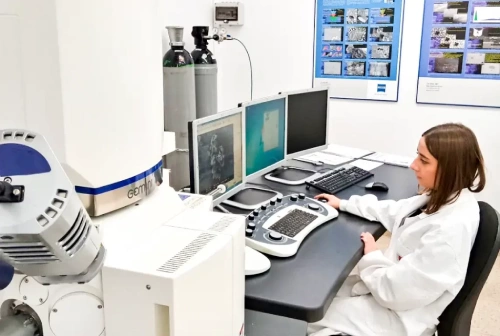Chemical Analytical Services
The PhotonExport standard operating procedures include delivering a Certificate of chemical analytical (COA) with each sputtering target provided. The techniques we use to provide the COA can include X-Ray Diffraction, Inductively Couple Plasma Spectroscopy (ICP-OES), or Glow-Discharge Mass Spectrometry (GDMS).
For non-metallic impurities, such as Oxygen, data is available upon request.

We can provide the following services of analysis for you:
Inductively Coupled Plasma Optical Emission Spectrometry (ICP-OES):
This Atomic Spectroscopy analysis is best suited for determining ratios of the bulk materials in an alloy.
ICP-OES is one of the most powerful and popular analytical tools for the determination of trace elements. The technique is based upon the spontaneous emission of photons from atoms and ions that have been excited in an RF discharge. Liquid and gas samples are injected directly into the analytical equipment. Solid samples require extraction or acid digestion, but the samples that can be analyzed can be very small – typically less than 1 ml or 50 mg.
ICP-OES analysis application
- High purity materials
- Sputtering Targets
- Metal alloys
Glow-Discharge Mass Spectrometry (GDMS) :
GDMS is best suited for determining metallic impurities. Generally used for (ultra-) trace analyses in metals and semi-conductors, Glow Discharge Optical Emission Spectroscopy (GDOES) provides rapid, direct bulk analysis and depth profiling analysis of solids like metals, glasses and ceramics with very high sensitivity. Large samples can be analyzed, provided they are flat, rigid, and large enough to cover the 4 mm diameter or 2 mm diameter anode. The process covers the full periodic table of elements, excluding Hydrogen.
GDMS can be utlized for two types of analyses:
- Surface profile analysis : a signal from each chemical element as a function of erosion time
- Bulk analysis : global chemical analysis
GDMS analysis application:
- Sputtering targets
- Metals, including refractory metals and alloys
- High purity materials
- Rare earth metals and their oxides
- Precious metals
- Bulk analysis (elemental compositions)
- Quantitative depth profile : analysis of the surface (in-depth profile) up to 100 µm
- Depending on the surface topology, layers of less than 100 nm are measurable
- Curved samples can also be analysed
